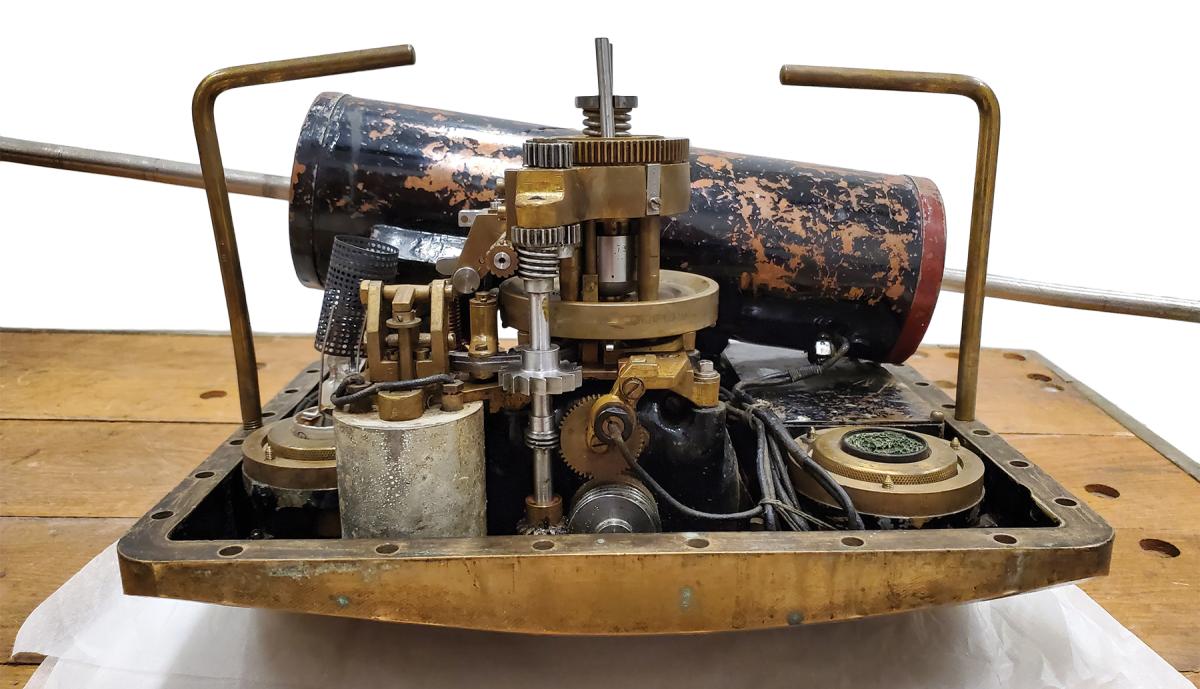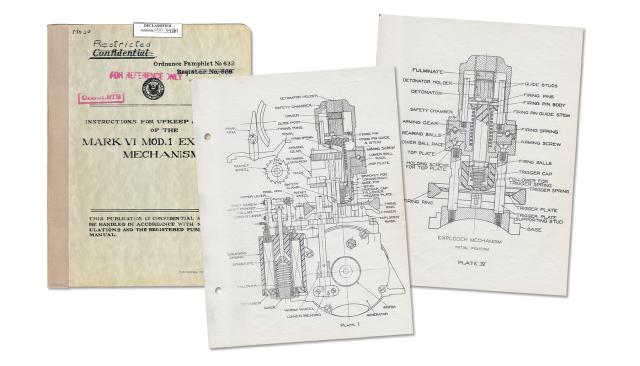In the late afternoon of 7 December 1941, Admiral Harold “Betty” Stark issued orders to naval forces in the Pacific to execute unrestricted submarine warfare against Japan. With the nation’s submarines one of the few offensive assets untouched at Pearl Harbor, crews went to sea armed with the Mk 14 torpedo—and its secretive, 90-pound Mk 6 Mod 1 exploder.
The exploder’s potential lay in its magnetic influence pistol. The device operated by detecting the electromagnetic field generated by a steel-hulled ship passing through salt water and tripping a trigger mechanism. Early torpedoes relied on contact exploders, which activated when the torpedo impacted the side of a vessel. While able to leave a hole in a hull, the hit would not guarantee the destruction of the target.
As armor belts and torpedo blisters increased on warships, a successful submarine attack in turn required greater torpedo hits. If, however, a torpedo could be made to explode a few feet beneath a hull, the energy of the warhead’s detonation would travel upward, displacing water and the target’s hull until both moved downward, fracturing the keel and breaking the ship in two. Armed with a magnetic influence exploder, a single torpedo could destroy a single target.
On 30 June 1922, the Bureau of Ordnance directed the Newport Torpedo Station to establish a project to develop an improved exploder. After four years of work under a cloak of extreme secrecy, the first tests for the experimental Mk 6 took place off Newport on 26 May 1926. Torpedo station personnel fired two Mk 10 torpedoes fitted with the magnetic influence exploders at the obsolete submarine L-8. The first torpedo passed under the target and failed to explode, but the second detonated under the keel as planned, breaking the boat in two.
The operation of the Mk 6 exploder involved a series of electrical, mechanical, and chemical functions for detonation. On the bronze base of the exploder was an impeller; after the torpedo left the submarine, the flow of water spun the impeller and powered a generator. The generator then supplied electrical energy for the exploder’s circuitry—oriented around a thyratron tube, a voltage regulator tube, and a solenoid.
The voltage regulator worked to ensure a constant rate of current. The thyratron, acting as a delayed electrical switch, activated the solenoid controlling the actual firing mechanism. A pickup coil provided operation’s critical component sensor: a 20-pound can holding a tightly packed coil of wire through which passed a 34-inch magnetic, highly permalloy core rod. This rod increased the magnitude of magnetic flux from the coil, and together they produced a small, fluctuating voltage output as the exploder passed through the earth’s magnetic field en route to the target.
When reaching a ship’s hull, the sudden proximity between pickup coil and metallic target changed the magnetic field’s direction, unleashing the flow of energy to the thyratron, which triggered and sent current to the solenoid. The solenoid moved an armature; the armature activated a pawl; the pawl engaged a ratchet wheel and moved a lever; the lever displaced the exploder mechanism’s firing ring; the displaced ring released the energy of a captive spring; the spring drove a small guide plate with two small firing pins; the pins shot upward on guide rods and impacted a fulminated-mercury cap. The released chemical energy activated a charge of tetryl, which detonated the warhead’s primary charge.
All of this overly complicated firing operation occurred in a fraction of a second.
Within the first weeks of World War II, however, the Mk 6 failed to meet expectations. Exploders were prematurely blowing up or impacting hulls without detonation. Arriving at its target, the exploder did sense the magnetic-field changes—but the magnitude varied depending on the ship’s latitude from the earth’s poles. The exploder’s performance against a target, therefore, depended on the latitude where it was used. On 24 June 1943, Admiral Chester Nimitz, Commander-in-Chief, Pacific Fleet, issued orders to deactivate the magnetic exploder. Premature explosions ceased, but the Mk 6 remained flawed.
Now equipped with essentially a contact exploder, torpedoes were impacting ships but not detonating. Tests conducted in August and September 1943 under the guidance of Rear Admiral Charles Lockwood, Commander, Submarines, Pacific Fleet, revealed that the firing-pin guide rods were distorting on high-speed impact with a target. This distortion increased friction and impaired the ability of the pins to strike the fulminated mercury with sufficient force to detonate it. Use of lightweight firing-pin guides proved the solution and finally made the Mk 6 reliable by October.
The Mk 6 Mod 1 exploder on view here—from the collection of the Smithsonian Institution’s National Museum of American History—has an enigmatic history. The museum acquired the device, serial number 2086, in its original shipping box in 1975 from the National Armed Forces Advisory Board. Within the box is a form listing the exploder as assigned to the destroyer USS Hilary P. Jones (DD-427) and being inspected and tested on board the destroyer tender Prairie (AD-15) on 9 June 1941.
Most intriguing of all about Mk 6 Mod 1 exploder 2086 is that it is a fired example. The voltage regulator tube is missing, and the thyratron is badly damaged. The firing-pin guide rods are visibly distorted. Exactly what transpired either in testing or operational use remains unknown pending further research. Looking at the artifact, one cannot help but wonder how the course of the Pacific war would have differed . . . had the exploder functioned as designed when the war began in December 1941.
—Dr. Frank A. Blazich Jr.,
National Museum of American History








